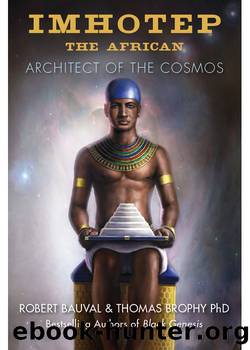Imhotep the African by Robert Bauval

Author:Robert Bauval
Language: eng
Format: epub
ISBN: 9781609258603
Publisher: Red Wheel Weiser
The Hoof of Mesekhtiu
We have established that the orientation and inclination of the serdab of the Step Pyramidâand consequently the whole complex to which it is attachedâare:
Azimuth 4° 35â²
Altitude over horizon line 16° 30â²
As noted earlier, when Lauer examined the inner core of the Step Pyramid, he concluded that there was originally a square mastaba that was eventually extended to become the pyramid. According to Lauer, this square mastaba, which had almost vertical walls, was first enlarged and then further extended and its walls made to slant at 16° 30'. In further extensions, the walls were made to extend upward in a series of six graduated steps, but retaining the angle of 16° 30' for each step, creating the Step Pyramid that we see today.
There are two descending passages in the north face of the pyramid: one with steps starting at the midpoint, and another very much cruder passage farther to the west. Could this latter passage be older? It is entirely possible that, when Imhotep started his own architectural work, the square mastaba was already there, and that its orientation and inclination were retained. And if, as we now suspect, the square mastaba was from the Early Dynastic period, as were the vases and jars found in the galleries directly underneath it, we needed to examine the sky at the rising of Sirius in 3100 BC, circa the start of the 1st Dynasty.
Using our StaryNight Pro astronomy software, we focused on the latitude of Saqqara (29° 52' N, 31° 13' E), the year 3100 BC, and the time one hour before sunrise. Allowing 1° altitude for Sirius with the sun at â10° 37' altitude (below horizon line), we found that the heliacal rising of Sirius occurred on the day of the Summer Solstice, July 19 Julian. A similar date, within a hundred years, was calculated by Austrian astronomer Theodor von Oppolzer:
We find that the Heliacal Rising of Sothis (Sirius), the Summer Solstice, and the annual rise of the river Nile coincided in the year 3000 BC Julian in the latitude of Memphis on July 18 Julian.202
Richard Parker, an expert on the ancient Egyptian calendar, gives a date of 2937 BC.203 M. F. Ingham calculated 2769 BC for a first day of Thoth-Sirius heliacal rising.204
In an appendix to our book Black Genesis, we review the calculation of Sothic Cycles, and note that, in this epoch, the heliacal rising of Sirius generally took place near the day of the Summer Solstice. We could not be precise as to the specific year, because exactly how far beneath the horizon the sun needs to be in order to sight the star Sirius is not definite, although it is generally held to be when the sun is about 10° beneath the horizon when the star is 1° altitude. But because Sirius is very bright, it is possible that it could be sighted when the sky was even brighter. In Black Genesis, we noted that a Summer Solstice heliacal rising of Sirius could plausibly be
Download
This site does not store any files on its server. We only index and link to content provided by other sites. Please contact the content providers to delete copyright contents if any and email us, we'll remove relevant links or contents immediately.
The Daily Stoic by Holiday Ryan & Hanselman Stephen(3238)
The Fate of Rome: Climate, Disease, and the End of an Empire (The Princeton History of the Ancient World) by Kyle Harper(3007)
People of the Earth: An Introduction to World Prehistory by Dr. Brian Fagan & Nadia Durrani(2702)
Ancient Worlds by Michael Scott(2627)
Babylon's Ark by Lawrence Anthony(2622)
The Daily Stoic by Ryan Holiday & Stephen Hanselman(2466)
Foreign Devils on the Silk Road: The Search for the Lost Treasures of Central Asia by Peter Hopkirk(2434)
India's Ancient Past by R.S. Sharma(2417)
MOSES THE EGYPTIAN by Jan Assmann(2374)
The Complete Dead Sea Scrolls in English (7th Edition) (Penguin Classics) by Geza Vermes(2237)
Lost Technologies of Ancient Egypt by Christopher Dunn(2195)
The Earth Chronicles Handbook by Zecharia Sitchin(2180)
24 Hours in Ancient Rome by Philip Matyszak(2051)
Alexander the Great by Philip Freeman(2034)
Aztec by Gary Jennings(1977)
The Nine Waves of Creation by Carl Johan Calleman(1884)
Curse Tablets and Binding Spells from the Ancient World by Gager John G.;(1838)
Before Atlantis by Frank Joseph(1814)
Earthmare: The Lost Book of Wars by Cergat(1792)
